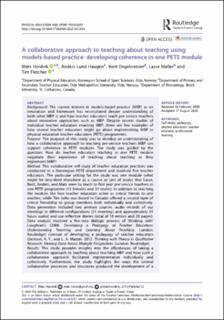| dc.contributor.author | Hordvik, Mats Melvold | |
| dc.contributor.author | Haugen, Anders L. Hage | |
| dc.contributor.author | Engebretsen, Berit | |
| dc.contributor.author | Møller, Lasse | |
| dc.contributor.author | Fletcher, Tim | |
| dc.date.accessioned | 2021-02-01T11:31:48Z | |
| dc.date.available | 2021-02-01T11:31:48Z | |
| dc.date.created | 2020-08-31T12:29:50Z | |
| dc.date.issued | 2020 | |
| dc.identifier.citation | Physical Education and Sport Pedagogy. 2020, under utgivelse. | en_US |
| dc.identifier.issn | 1740-8989 | |
| dc.identifier.uri | https://hdl.handle.net/11250/2725549 | |
| dc.description | This is an Open Access article distributed under the terms of the Creative Commons Attribution-NonCommercial-NoDerivatives License (http://creativecommons.org/licenses/by-nc-nd/4.0/), which permits non-commercial re-use, distribution, and reproduction in any medium, provided the original work is properly cited, and is not altered, transformed, or built upon in any way. | en_US |
| dc.description.abstract | Background: The current interest in models-based practice (MBP) as an innovation and framework has necessitated deeper understanding of both what MBP is and how teacher educators teach pre-service teachers about innovative approaches such as MBP. Despite several studies of individual teacher educators enacting MBP, there are few examples of how several teacher educators might go about implementing MBP in physical education teacher education (PETE) programmes. Purpose: The purpose of this study was to develop an understanding of how a collaborative approach to teaching pre-service teachers MBP can support coherence in PETE modules. The study was guided by the question: How do teacher educators teaching in one PETE module negotiate their experience of teaching about teaching as they implement MBP? Method: This collaborative self-study of teacher education practices was conducted in a Norwegian PETE department and involved five teacher educators. The particular setting for the study was one module (what might be described elsewhere as a course or unit of study) that Lasse, Berit, Anders, and Mats were to teach to first year pre-service teachers in one PETE programme (13 females and 37 males). In addition to teaching the module, the four teacher educators acted as critical friends to one another, while Tim (who was based in Canada) offered a second layer of critical friendship to group members both individually and collectively. Data generation included two primary sources: audio records of our meetings in different configurations (21 meetings and approximately 35 hours audio) and our reflective diaries (total of 10 entries and 20 pages). Data analysis involved a five-step dialogic process of ‘thinking with' Loughran’s (2006. Developing a Pedagogy of Teacher Education: Understanding Teaching and Learning About Teaching. London: Routledge) concept of developing a pedagogy of teacher education (Jackson, A. Y., and L. A. Mazzei. 2012. Thinking with Theory in Qualitative Research: Viewing Data Across Multiple Perspectives. London: Routledge). Results: This study provides insights into the affordances of taking a collaborative approach to teaching about teaching MBP and how such a collaborative approach facilitated implementation individually and collectively. Furthermore, the study highlights the ways the several collaborative processes and structures produced the development of a shared language and vision for teaching about teaching MBP. This shared vision led to coherence in how we talked and taught about MBP with each other and with pre-service teachers. These visions helped make our individual and collective practices and their articulation coherent to ourselves and to one another, and also to the pre-service teachers whom we taught. Conclusion: Our understanding is that the development of coherent PETE programmes and the modules within those programmes requires at least: (i) a professional group of teacher educators who are willing to share their understanding, challenges, and uncertainties with one another and with pre-service teachers, (ii) an inquiry-oriented stance towards researching group and departmental beliefs and practices, and (iii) a desire to better understand and share the development of new understandings with colleagues at departmental, national, and/or international levels. | en_US |
| dc.language.iso | eng | en_US |
| dc.subject | self-study | en_US |
| dc.subject | pedagogy | en_US |
| dc.subject | teacher education | en_US |
| dc.subject | teacher educator | en_US |
| dc.subject | professional learning | en_US |
| dc.title | A collaborative approach to teaching about teaching using models-based practice: developing coherence in one PETE module | en_US |
| dc.type | Peer reviewed | en_US |
| dc.type | Journal article | en_US |
| dc.description.version | publishedVersion | en_US |
| dc.rights.holder | © 2020 The Author(s). | en_US |
| dc.source.pagenumber | 15 | en_US |
| dc.source.journal | Physical Education and Sport Pedagogy | en_US |
| dc.identifier.doi | 10.1080/17408989.2020.1812558 | |
| dc.identifier.cristin | 1826208 | |
| dc.description.localcode | Institutt for lærerutdanning og friluftslivsstudier / Department of Teacher Education and Outdoor Life Studies | en_US |
| cristin.ispublished | true | |
| cristin.fulltext | original | |
| cristin.qualitycode | 1 | |
